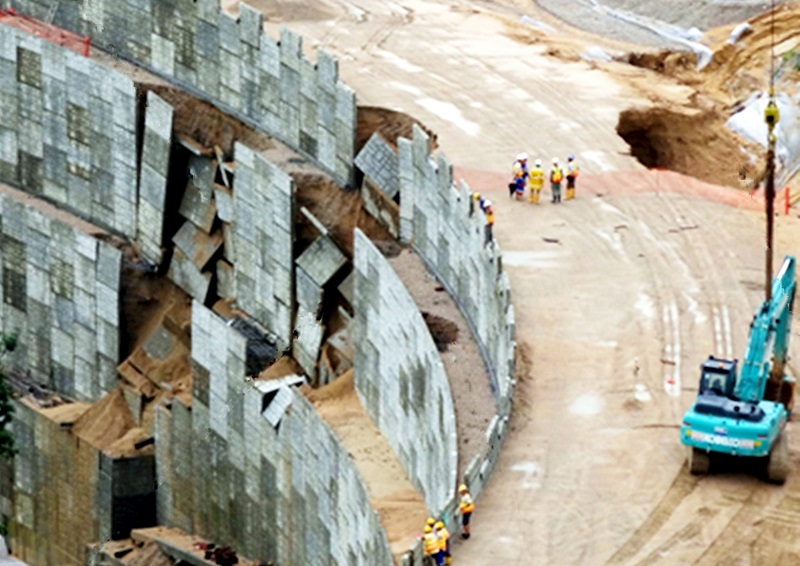Forensic investigations: can we trust them?

|
| A detailed forensic investigation of this collapsed reinforced earth wall under construction in Hong Kong found insufficient site drainage was the main cause. |
Contents |
[edit] Introduction
Forensic engineers aim to identify the causes of failure of constructed facilities. The results are often used in legal proceedings, so sound investigations and reporting are essential because they can result in severe consequences and penalties.
Other investigations aim to learn from the failures and improve practices. These investigations may lead to changes in company approaches or even in legislation. Reliable investigations are necessary in these situations, too, because erroneous conclusions might lead to insufficient measures.
The reliability of both types of investigations is therefore of utmost importance. Every phase of an investigation needs attention. This is the reason why ICE published a themed issue of its Forensic Engineering journal on the reliability of forensic investigations.
[edit] Quality assurance issues
When gathering facts after a failure, it is often not clear which facts are needed to find the causes.
How do you decide where to focus? Furthermore, when setting possible scenarios, this procedure is often limited by the scope of the client’s brief. What if you are not paid to look for possible scenarios that do not support the client’s interest?
Finally, when testing scenarios, what do you do with facts that do not match your most evident scenario? In short, what do you do to assure the quality of the investigation and reliability of the result?
Researchers with practical forensic experience from various faculties of Delft University of Technology tried to answer these questions by developing an integrated forensic investigation approach. They based their approach on established theories from the literature and also from human sciences.
Furthermore, they used best practices from forensic investigations in aerospace engineering, civil engineering and biomechanical engineering, with the aim to increase reliability of investigations.
[edit] Understanding human error
Professor Dekker, author of the very inspirational 2014 book ‘The Field Guide to Understanding ‘Human Error’’, was willing to contribute with an overview of possible biases to determine human influence in technical failures.
As over 90% of structural failures are attributed to human errors, it is important to understand better the reason people were acting as they did prior to a failure.
For many forensic investigations, instruments are used to provide information to determine the cause of a failure. Thorniley-Walker et al shared their experience in investigating settlement damage and they show that relatively simple movement gauges can provide reliable and useful information.
[edit] The importance of experience
To become a mature forensic engineer, it is important to gain experience. The themed issue also provides some examples of interesting case studies related to, especially, geotechnical structures, that can help readers to learn from the experience of other investigators.
Kog provides an overview of common causes for water leakages of underground structures. For design engineers, this paper provides useful lessons in avoiding or minimising these leakages in new designs.
Ashok Kumar et al describe a case study of an industrial building constructed on expansive soil in India. They stress that this type of failure results in billions of dollars’ worth of damage worldwide, and therefore a thorough understanding of this phenomenon is important.
A forensic investigation of these cracks in a four-year old industrial building in India found among other things that the rainwater harvesting system was leaking into the underlying expansive clay.
Finally, a large failure of a reinforced earth wall in Hong Kong has been thoroughly examined and nicely reported.
The described steps in the investigation, testing – also with an unmanned vehicle because of a dangerous situation – and careful examining of possible causes provide an example of what a thorough investigation could look like.
[edit] About this article
This article was written by Karel Terwel of Delft University of Technology, Holland. It appeared on the website of the Institution of Civil Engineers (ICE) in March 2019 and can be accessed here.
[edit] Related articles on Designing Buildings Wiki
Featured articles and news
One of the most impressive Victorian architects. Book review.
RTPI leader to become new CIOB Chief Executive Officer
Dr Victoria Hills MRTPI, FICE to take over after Caroline Gumble’s departure.
Social and affordable housing, a long term plan for delivery
The “Delivering a Decade of Renewal for Social and Affordable Housing” strategy sets out future path.
A change to adoptive architecture
Effects of global weather warming on architectural detailing, material choice and human interaction.
The proposed publicly owned and backed subsidiary of Homes England, to facilitate new homes.
How big is the problem and what can we do to mitigate the effects?
Overheating guidance and tools for building designers
A number of cool guides to help with the heat.
The UK's Modern Industrial Strategy: A 10 year plan
Previous consultation criticism, current key elements and general support with some persisting reservations.
Building Safety Regulator reforms
New roles, new staff and a new fast track service pave the way for a single construction regulator.
Architectural Technologist CPDs and Communications
CIAT CPD… and how you can do it!
Cooling centres and cool spaces
Managing extreme heat in cities by directing the public to places for heat stress relief and water sources.
Winter gardens: A brief history and warm variations
Extending the season with glass in different forms and terms.
Restoring Great Yarmouth's Winter Gardens
Transforming one of the least sustainable constructions imaginable.
Construction Skills Mission Board launch sector drive
Newly formed government and industry collaboration set strategy for recruiting an additional 100,000 construction workers a year.
New Architects Code comes into effect in September 2025
ARB Architects Code of Conduct and Practice available with ongoing consultation regarding guidance.
Welsh Skills Body (Medr) launches ambitious plan
The new skills body brings together funding and regulation of tertiary education and research for the devolved nation.
Paul Gandy FCIOB announced as next CIOB President
Former Tilbury Douglas CEO takes helm.























